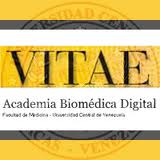Diagnóstico tardío de hipoacusia congénita en preescolares que asisten al instituto de educación especial: audición y lenguaje. Maracay, Estado Aragua.
Palabras clave:
hipoacusia, Diagnóstico tardío, hearing impairment, late hearing impairment diagnosisResumen
Anualmente, 6 de cada 1000 recién nacidos vivos a nivel mundial, presentan hipoacusia al momento del nacimiento o en el período neonatal. Dificultando el desarrollo lingüístico, y social del niño, por ello el American National Institute of Health recomienda el screening neonatal previo los 3 meses de edad. El principal objetivo fue determinar la prevalencia del diagnóstico tardío de hipoacusia, en preescolares que acudían al Instituto de Educación Especial: Audición y Lenguaje. Se recolectaron los datos mediante un cuestionario, que indagaba al representante características del diagnóstico de hipoacusia y se revisaron las historias médicas obteniendo el estrato social y factores de riesgo. Se utilizó el coeficiente de Spearman, y el Chi Cuadrado para el análisis estadístico. La frecuencia del Diagnóstico tardío de hipoacusia fue de un 96%, por eso se recomienda la implementación de políticas de detección neonatal de hipoacusia mediante emisiones otoacústicas siguiendo las guías internacionales antes descritas.Title
Late diagnosis of congenital Hearing Impairment in preschoolers who attend the Special Education Institute for Hearing and Language. Maracay, Venezuela
Abstract
Annually, up to 6 per 1000 live-born infants worldwide, suffer permanent hearing loss at birth or during the neonatal period. Such impairment is associated with defective language acquisition, and learning development. This fact supports the recommendation of The American National Institute of Health for universal neonatal screening in all infants younger than three months old. We investigated the prevalence of late Hearing Impairment diagnosis in preschoolers in the Special Education Institute. A survey was sent to the parents asking for several characteristics of children’s hearing impairment, and clinical histories provide information about social stratum, and risk factors. The Spearman coeficient, Fisher and Chi tests were used for statistical analisis. There were a 96% of late hearing impairment diagnosis in preschoolers. For this reason is important to prepare plans to prevent it, such as the universal neonatal screening with automated auditory brainstem responses
Descargas
Los datos de descargas todavía no están disponibles.
Descargas
Cómo citar
Koch, K., Cárdenas, C., Agüero, I., & Mirabal, M. (2013). Diagnóstico tardío de hipoacusia congénita en preescolares que asisten al instituto de educación especial: audición y lenguaje. Maracay, Estado Aragua. Vitae, (42). Recuperado a partir de http://saber.ucv.ve/ojs/index.php/rev_vit/article/view/4560
Número
Sección
Artículos

